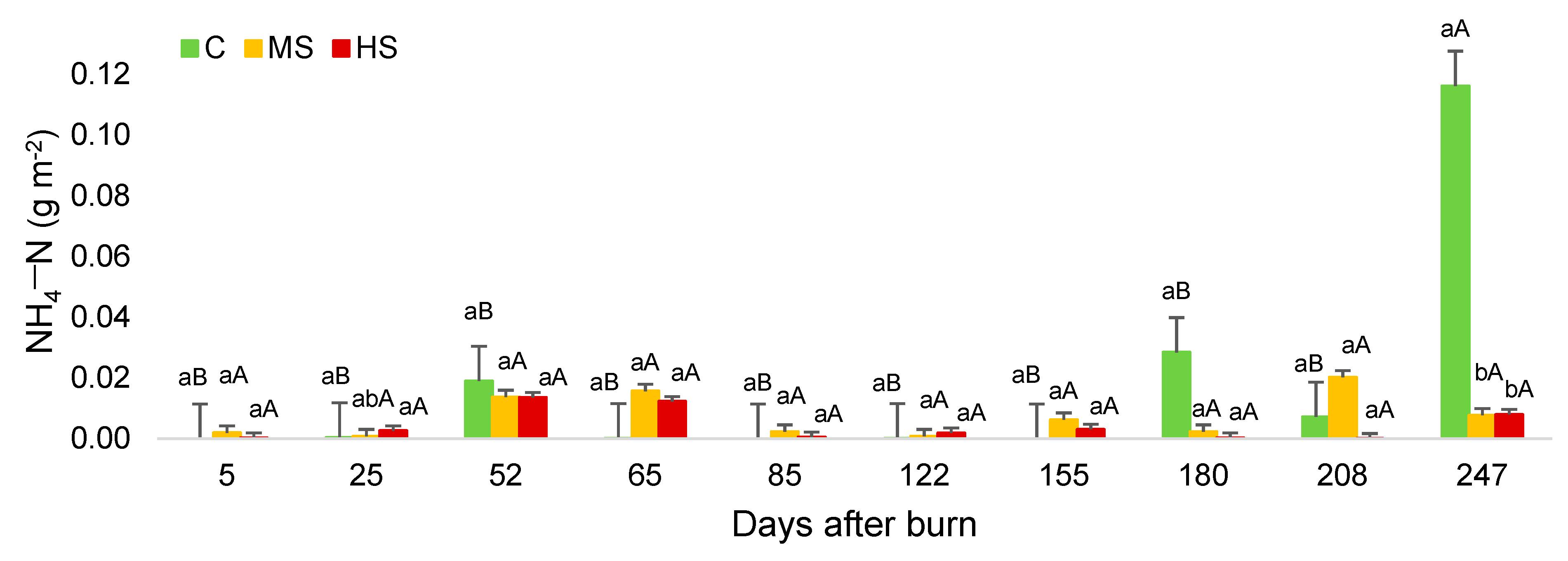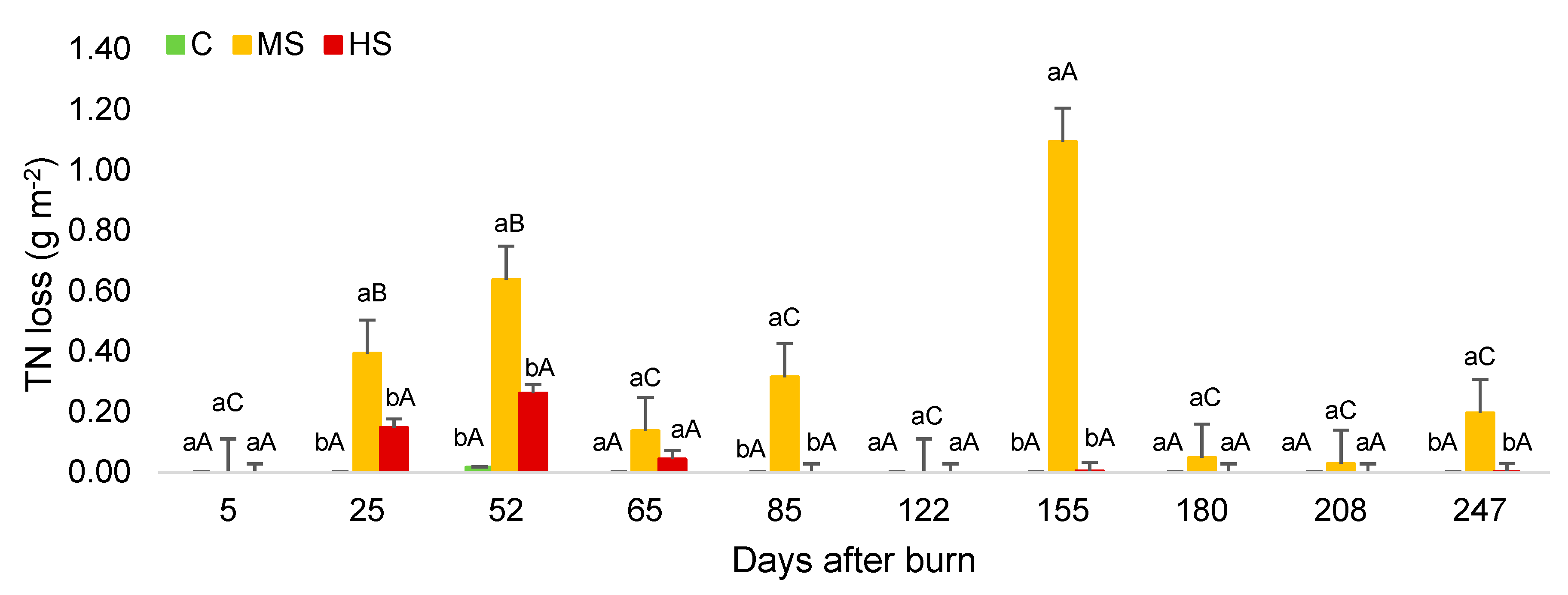Short-Term Effects of Pile Burn on N Dynamic and N Loss in Mediterranean Croatia
Abstract
1. Introduction
2. Materials and Methods
2.1. Study Site and Location
2.2. Experimental Designs and Laboratory Analyses
2.3. Statistical Analyses
3. Results
3.1. Post-Burn Rainfall
3.2. Ash and Surface TN Content
3.3. Runoff and Sediment Characteristic
3.4. Nitrogen Concentrations in Runoff
3.5. Nitrogen Loss in Sediment
3.6. Principal Component Analysis
4. Discussion
4.1. Ash and Soil TN Dynamics
4.2. Hydrological Response to Pile Burns
4.3. The N losses in the Post-Burn Period
4.4. Interrelations between Hydrological Variables
4.5. Implications for Land Management
5. Conclusions
Supplementary Materials
Author Contributions
Funding
Acknowledgments
Conflicts of Interest
References
- Moreira, F.; Viedma, O.; Arianoutsou, M.; Curt, T.; Koutsias, N.; Rigolot, E.; Barbati, A.; Corona, P.; Vaz, P.; Xanthopoulos, G.; et al. Landscape—Wildfire interactions in southern Europe: Implications for landscape management. J. Environ. Manag. 2011, 92, 2389–2402. [Google Scholar] [CrossRef] [PubMed]
- Lasanta, T.; Khorchani, M.; Pérez-Cabello, F.; Errea, P.; Sáenz-Blanco, R.; Nadal-Romero, E. Clearing shrubland and extensive livestock farming: Active prevention to control wildfires in the Mediterranean mountains. J. Environ. Manag. 2018, 227, 256–266. [Google Scholar] [CrossRef] [PubMed]
- Curt, T.; Frejaville, T. Wildfire Policy in Mediterranean France: How Far is it Efficient and Sustainable? Risk Anal. 2018, 38, 472–488. [Google Scholar] [CrossRef] [PubMed]
- Busse, M.D.; Shestak, C.J.; Hubbert, K.R. Soil heating during burning of forest slash piles and wood piles. Int. J. Wildland Fire 2013, 22, 786–796. [Google Scholar] [CrossRef]
- Pastor, E.; Pérez, Y.; Agueda, A.; Miralles, M.; Planas, E. Pile burning of cutting debris in stands of hazel (Corylus avellana): An experimental study of smouldering combustion towards the validation of a burning protocol. Fire Saf. J. 2010, 45, 69–81. [Google Scholar] [CrossRef]
- Kostenidou, E.; Kaltsonoudis, C.; Tsiflikiotou, M.; Louvaris, E.; Russell, L.M.; Pandis, S.N. Burning of olive tree branches: A major organic aerosol source in the Mediterranean. Atmos. Chem. Phys. Discuss. 2013, 13, 7223–7266. [Google Scholar] [CrossRef]
- Francos, M.; Úbeda, X.; Pereira, P. Impact of bonfires on soil properties in an urban park in Vilnius (Lithuania). Environ. Res. 2020, 181, 108895. [Google Scholar] [CrossRef]
- Pereira, P.; Francos, M.; Brevik, E.C.; Ubeda, X.; Bogunovic, I. Post-fire soil management. Curr. Opin. Environ. Sci. Health 2018, 5, 26–32. [Google Scholar] [CrossRef]
- Thomas, A.D.; Walsh, R.P.D.; Shakesby, R.A. Nutrient losses in eroded sediment after fire in eucalyptus and pine forests in the wet Mediterranean environment of northern Portugal. Catena 1999, 36, 283–302. [Google Scholar] [CrossRef]
- Caon, L.; Vallejo, V.R.; Coen, R.J.; Geissen, V. Effects of wildfire on soil nutrients in Mediterranean ecosystems. Earth Sci. Rev. 2014, 139, 47–58. [Google Scholar] [CrossRef]
- Certini, G. Effects of fire on properties of forest soils: A review. Oecologia 2005, 143, 1–10. [Google Scholar] [CrossRef] [PubMed]
- Bodí, M.B.; Martin, D.A.; Balfour, V.N.; Santín, C.; Doerr, S.H.; Pereira, P.; Cerdà, A.; Mataix-Solera, J. Wildland fire ash: Production, composition and eco-hydro-geomorphic effects. Earth Sci. Rev. 2014, 130, 103–127. [Google Scholar] [CrossRef]
- Shakesby, R.A. Post-wildfire soil erosion in the Mediterranean: Review and future research directions. Earth Sci. Rev. 2011, 105, 71–100. [Google Scholar] [CrossRef]
- Neary, D.G.; Ryan, K.C.; DeBano, L.F. Wildland Fire in Ecosystems: Effects of Fire on Soils and Water; Gen. Tech. Rep. RMRS-GTR-42-vol.4; CreateSpace Independent Publishing Platform: Scotts Valley, CA, USA, 2005. [Google Scholar]
- Wan, S.; Hui, D.; Luo, Y. Fire effects on nitrogen pools and dynamics in terrestrial ecosystems: A meta-analysis. Ecological 2001, 11, 711–730. [Google Scholar] [CrossRef]
- Smith, H.G.; Sheridan, G.J.; Lane, P.N.J.; Nyman, P.; Haydon, S. Wildfire effects on water quality in forest catchments: A review with implications for water supply. J. Hydrol. 2011, 396, 170–192. [Google Scholar] [CrossRef]
- Pereira, P.; Brevik, E.; Bogunović, I.; Ferran, E.-S. Ash and soils: A Close Relationship in Fire-Affected Areas. In Fire Effects on Soil Properties; Pereira, P., Mataix-Solera, J., Úbeda, X., Rein, G., Cerdà, A., Eds.; CSIRO Publishing: Clayton, Australia, 2019; ISBN 9781486308149. [Google Scholar]
- Certini, G.; Nocentini, C.; Knicker, H.; Arfaioli, P.; Rumpel, C. Wildfire effects on soil organic matter quantity and quality in two fire-prone Mediterranean pine forests. Geoderma 2011, 167, 148–155. [Google Scholar] [CrossRef]
- Johnson, B.G.; Johnson, D.W.; Miller, W.W.; Carroll-Moore, E.M.; Board, D.I. The effects of slash pile burning on soil and water macronutrients. Soil Sci. 2011, 176, 413–425. [Google Scholar] [CrossRef]
- Hubbert, K.R.; Busse, M.; Overby, S.; Shestak, C.; Gerrard, R. Pile burning effects on soil water repellency, infiltration, and downslope water chemistry in the lake tahoe basin, USA. Fire Ecol. 2015, 11, 100–118. [Google Scholar] [CrossRef]
- Koyama, A.; Stephan, K.; Kavanagh, K.L. Fire effects on gross inorganic N transformation in riparian soils in coniferous forests of central Idaho, USA: Wildfires v. prescribed fires. Int. J. Wildland Fire 2012, 21, 69. [Google Scholar] [CrossRef]
- Stephan, K.; Kavanagh, K.L.; Koyama, A. Comparing the Influence of Wildfire and Prescribed Burns on Watershed Nitrogen Biogeochemistry Using 15N Natural Abundance in Terrestrial and Aquatic Ecosystem Components. PLoS ONE 2015, 10, e0119560. [Google Scholar] [CrossRef]
- Ferreira, R.V.; Serpa, D.; Machado, A.I.; Rodríguez-Blanco, M.L.; Santos, L.F.; Taboada-Castro, M.T.; Cerqueira, M.A.; Keizer, J.J. Short-term nitrogen losses by overland flow in a recently burnt forest area in north-central Portugal: A study at micro-plot scale. Sci. Total Environ. 2016, 572, 1281–1288. [Google Scholar] [CrossRef] [PubMed]
- Sharma, U.; Sharma, J.; Devi, M.; Uday Sharma, C. Effect of Forest fire on soil nitrogen mineralization and microbial biomass: A review. J. Pharmacogn. Phytochem. 2017, 6, 682–685. [Google Scholar]
- Kottek, M.; Grieser, J.; Beck, C.; Rudolf, B.; Rubel, F. World map of the Köppen-Geiger climate classification updated. Meteorol. Z. 2006, 15, 259–263. [Google Scholar] [CrossRef]
- USDA. Soil Conservation Service. In Munsell Soil Color Book; Agricultural Handbook No. 18; U.S. Government Printing Office: Washington, DC, USA, 2009. [Google Scholar]
- DeBano, L.F.; Neary, D.G.; Ffolliott, P. Fire Effects on Ecosystems; John Wiley & Sons: Hoboken, NJ, USA, 1998; ISBN 978-0-471-16356-5. [Google Scholar]
- Rau, B.M.; Tausch, R.; Reiner, A.; Johnson, D.W.; Chambers, J.C.; Blank, R.R.; Lucchesi, A. Influence of prescribed fire on ecosystem biomass, carbon, and nitrogen in a pinyon juniper woodland. Rangel. Ecol. Manag. 2010, 63, 197–202. [Google Scholar] [CrossRef][Green Version]
- Johnson, B.G.; Johnson, D.W.; Miller, W.W.; Board, D.I. The effects of ash influx on burned and unburned soil water-extractable nutrients using a mechanical vacuum extractor. Soil Sci. 2012, 177, 338–344. [Google Scholar] [CrossRef]
- Dinis Ferrira, A.J.; Leitao, I.A.; Boulet, A.K.; Santos Ferreira, C.S. Nutrient Processes. In Fire Effects on Soil Properties; Pereira, P., Mataix-Solera, J., Úbeda, X., Rein, G., Cerdà, A., Eds.; CSIRO Publishing: Clayton, Australia, 2019; pp. 129–142. [Google Scholar]
- Francos, M.; Úbeda, X.; Pereira, P.; Alcañiz, M. Long-term impact of wildfire on soils exposed to different fire severities. A case study in Cadiretes Massif (NE Iberian Peninsula). Sci. Total Environ. 2018, 615, 664–671. [Google Scholar] [CrossRef]
- Boerner, R.E.J.; Huang, J.; Hart, S.C. Impacts of Fire and Fire Surrogate treatments on forest soil properties: A meta-analytical approach. Ecol. Appl. 2009, 19, 338–358. [Google Scholar] [CrossRef]
- Zavala, L.M.; de celis, R.; Jordán, A. How wildfires affect soil properties. A brief review. Cuad. Investig. Geogr. 2014, 40, 311–331. [Google Scholar] [CrossRef]
- Shakesby, R.A.; Doerr, S.H. Wildfire as a hydrological and geomorphological agent. Earth Sci. Rev. 2006, 74, 269–307. [Google Scholar] [CrossRef]
- Moody, J.A.; Martin, D.A.; Haire, S.L.; Kinner, D.A. Linking runoff response to burn severity after a wildfire. Hydrol. Process. 2008, 22, 2063–2074. [Google Scholar] [CrossRef]
- Benavides-Solorio, J.; MacDonald, L.H. Post-fire runoff and erosion from simulated rainfall on small plots, Colorado Front Range. Hydrol. Process. 2001, 15, 2931–2952. [Google Scholar] [CrossRef]
- Soto, B.; Diaz-Fierros, F. Interactions between plant ash leachates and soil. Int. J. Wildland Fire 1993, 3, 207–216. [Google Scholar] [CrossRef]
- Gimeno-García, E.; Andreu, V.; Rubio, J.L. Influence of vegetation recovery on water erosion at short and medium-term after experimental fires in a Mediterranean shrubland. Catena 2007, 69, 150–160. [Google Scholar] [CrossRef]
- Pereira, P.; Cerdà, A.; Úbeda, X.; Mataix-Solera, J.; Arcenegui, V.; Zavala, L.M. Modelling the Impacts of Wildfire on Ash Thickness in a Short-Term Period. Land Degrad. Dev. 2015, 26, 180–192. [Google Scholar] [CrossRef]
- Mataix-Solera, J.; Arcenegui, V.; Guerrero, C.; Jordán, M.M.; Dlapa, P.; Tessler, N.; Wittenberg, L. Can terra rossa become water repellent by burning? A laboratory approach. Geoderma 2008, 147, 178–184. [Google Scholar] [CrossRef]
- Cerdà, A.; Doerr, S.H. The effect of ash and needle cover on surface runoff and erosion in the immediate post-fire period. Catena 2008, 74, 256–263. [Google Scholar] [CrossRef]
- Onda, Y.; Dietrich, W.E.; Booker, F. Evolution of overland flow after a severe forest fire, Point Reyes, California. Catena 2008, 72, 13–20. [Google Scholar] [CrossRef]
- Zheng, F.L.; Zhang, Y.B.; Cao, N. Effect of saturated near surface on nitrate and ammonia nitrogen losses in surface runoff at the loess soil hillslope. Int. J. Chem. Eng. 2010, 2010. [Google Scholar] [CrossRef]
- Riggan, P.J.; Lockwood, R.N.; Jacks, P.M.; Colver, C.G.; Weirich, F.; DeBano, L.F.; Brass, J.A. Effects of Fire Severity on Nitrate Mobilization in Watersheds Subject to Chronic Atmospheric Deposition. Environ. Sci. Technol. 1994, 28, 369–375. [Google Scholar] [CrossRef]
- Hart, S.C.; DeLuca, T.H.; Newman, G.S.; MacKenzie, M.D.; Boyle, S.I. Post-fire vegetative dynamics as drivers of microbial community structure and function in forest soils. For. Ecol. Manag. 2005, 220, 166–184. [Google Scholar] [CrossRef]
- Field, J.P.; Farrish, K.W.; Carter, E.A. Soil and nutrient losses following site preparation burning in a harvested loblolly pine site. Trans. Am. Soc. Agric. Eng. 2003, 46, 1697–1703. [Google Scholar] [CrossRef][Green Version]
- Hosseini, M.; Geissen, V.; González-Pelayo, O.; Serpa, D.; Machado, A.I.; Ritsema, C.; Keizer, J.J. Effects of fire occurrence and recurrence on nitrogen and phosphorus losses by overland flow in maritime pine plantations in north-central Portugal. Geoderma 2017, 289, 97–106. [Google Scholar] [CrossRef]
- Pausas, J.G.; Fernández-Muñoz, S. Fire regime changes in the Western Mediterranean Basin: From fuel-limited to drought-driven fire regime. Clim. Chang. 2012, 110, 215–226. [Google Scholar] [CrossRef]
- Busse, M.D.; Hubbert, K.R.; Moghaddas, E.E.Y. Fuel reduction practices and their effects on soil quality. Gen. Tech. Rep. 2014, 156, 241. [Google Scholar]
- Wright, C.S.; Evans, A.M.; Grove, S.; Haubensak, K.A. Pile age and burn season influence fuelbed properties, combustion dynamics, fuel consumption, and charcoal formation when burning hand piles. For. Ecol. Manag. 2019, 439, 146–158. [Google Scholar] [CrossRef]











| Ash TN (%) | Soil TN (%) | ||||
|---|---|---|---|---|---|
| Time after Burn | IAB | 5 DAB | 122 DAB | 247 DAB | p Value |
| C | / | 0.50aA | 0.45bA | 0.46bA | * |
| MS | 0.27A | 0.46aB | 0.44aA | 0.45aA | n.s. |
| HS | 0.25A | 0.45aB | 0.45aA | 0.48aA | n.s. |
© 2020 by the authors. Licensee MDPI, Basel, Switzerland. This article is an open access article distributed under the terms and conditions of the Creative Commons Attribution (CC BY) license (http://creativecommons.org/licenses/by/4.0/).
Share and Cite
Delač, D.; Pereira, P.; Bogunović, I.; Kisić, I. Short-Term Effects of Pile Burn on N Dynamic and N Loss in Mediterranean Croatia. Agronomy 2020, 10, 1340. https://doi.org/10.3390/agronomy10091340
Delač D, Pereira P, Bogunović I, Kisić I. Short-Term Effects of Pile Burn on N Dynamic and N Loss in Mediterranean Croatia. Agronomy. 2020; 10(9):1340. https://doi.org/10.3390/agronomy10091340
Chicago/Turabian StyleDelač, Domina, Paulo Pereira, Igor Bogunović, and Ivica Kisić. 2020. "Short-Term Effects of Pile Burn on N Dynamic and N Loss in Mediterranean Croatia" Agronomy 10, no. 9: 1340. https://doi.org/10.3390/agronomy10091340
APA StyleDelač, D., Pereira, P., Bogunović, I., & Kisić, I. (2020). Short-Term Effects of Pile Burn on N Dynamic and N Loss in Mediterranean Croatia. Agronomy, 10(9), 1340. https://doi.org/10.3390/agronomy10091340







